|
Yosemite National Park plays a significant role in the imagination, culture, and history of California and the United States. It is a land of contrasts, with its thundering waterfalls, soaring granite cliffs, serene meadows, and the largest trees on earth. Yosemite is also a wellspring of human aspiration. It is the birthplace of the national park movement, a muse for writers, painters, and photographers, and a natural resource that has fueled the growth of California and the Western United States. Our goal with Yosemite: Then and Now is to tell the park’s story by matching beautiful and fascinating archival photographs with photos from today. Join us as we reveal the hidden history of familiar locations. The galleries of this collection are set up thematically and mostly chronologically, from the earliest explorers in the 1850s to mask-wearing tourists visiting in 2020. Click on the titles below to go to each gallery. And please check back periodically as we are building this collection over time. 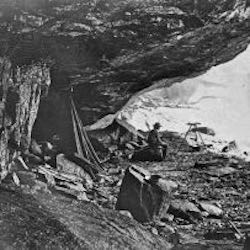
Explorers and RecordersAfter the Mariposa Battalion became the first known European Americans to enter Yosemite Valley in 1851, doors opened for intrepid tourists and promoters to exploit the extraordinary natural wonder of Yosemite Valley and the Mariposa Grove of Giant Sequoias. Painters and photographers like Thomas Ayres, Albert Bierstadt, Thomas Hill, Charles Leander Weed, and Carleton Watkins provided imagery as evidence needed for Congress and President Lincoln to establish the original Yosemite Grant in 1864. Promoters Walworth and Hite, James Hutchings, and George Leidig found the imagery useful to encourage visitation to the newly protected lands. 
Early Tourism – Lodging and PreservationPromoters established rough accommodations as early as 1857 to house tourists and scientists, such as Clarence King and Charles Hoffmann of the Geological Survey of California. The state of California built the Stoneman House in 1887 in an attempt to provide finer accommodations than previously afforded. John Degnan and his wife established a bakery in 1884 that eventually became the store and restaurant present today. The Currys, former teachers who provided camping tours during their summer vacation, arrived in 1899. Their venture evolved into the Curry Village of today. 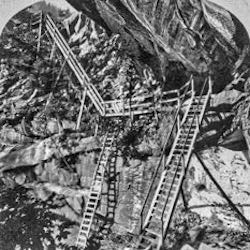
Early Tourism - Roads and TrailsFor tourists to get to Yosemite before the automobile, they sailed from San Francisco to Stockton, boarded a stage for a rough, dusty ride to Mariposa or Coulterville, then rode with their luggage up various horse trails. The Mann Toll Horse Trail opened in 1856. Riders traveled 45 miles from Mariposa to Wawona, then followed old Indian routes into the valley floor near Bridalveil Fall. There are now roughly 800 miles of trail in Yosemite. John Conway, described by John Muir as “the master trail builder of the Valley,” configured the Yosemite Falls Trail with its 60 switchbacks, the Chilnualna Falls Trail near Wawona, and the Four Mile Trail from Yosemite Valley to Glacier Point. 
Roosevelt, Muir, and the Grace of PlaceIn 1903, President Theodore Roosevelt visited Yosemite and was guided by naturalist John Muir. The two men spent three memorable nights camping first under the outstretched arms of the Grizzly Giant in the Mariposa Grove, then in a snowstorm atop five feet of snow near Sentinel Dome, and finally in a meadow near the base of Bridalveil Falls. Their conversations and shared joy with the beauty and magnificence of Yosemite led Roosevelt to expand federal protection of Yosemite, and it inspired him to sign into existence five national parks, 18 national monuments, 55 national bird sanctuaries and wildlife refuges, and 150 national forests. 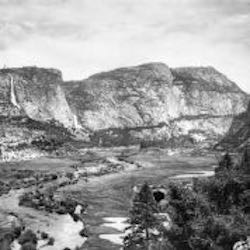
Encroaching Civilization - Dams and TrainsCalifornia’s growth after the gold rush and the completion of the transcontinental railway accelerated demand for natural resources from the Sierra Nevada mountains. The city of San Francisco, in particular, reached into the Sierra initially for wood to house its expanding population. After the 1906 earthquake and fire exposed the vulnerability of the city’s water supply, San Francisco moved aggressively to tap the fresh water flowing from Yosemite’s highest alpine peaks through the Hetch Hetchy Valley. 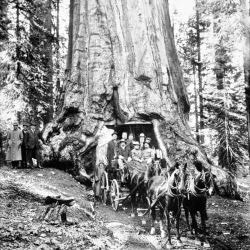
Encroaching Civilization - Visitor ActivitiesAs the population grew and word of Yosemite’s magnificence spread, tourists came from across the globe to see its wonders for themselves. Tunnels were carved through giant sequoias. Politicians, artists, Olympians, soldiers, and everyday travelers made the pilgrimage to pose in front of the grand waterfalls and granite vistas. 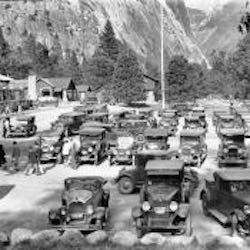
Encroaching Civilization - Visitor ServicesTo accommodate the rapidly expanding number of visitors, infrastructure was built to service and house them. A variety of lodging was established from the rugged tent cabins of Camp Curry to the stately grandeur of The Ahwahnee. Sensitive meadow habitats were paved and trees removed for roads, parking lots, stores, restaurants, and ski runs. Even some hiking trails were paved. 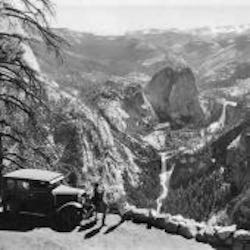
Encroaching Civilization - TransportationThe first automobile bumped its way into Yosemite Valley in 1900, dramatically expanding access for tourists. Roads were improved, Tioga Pass opened to cars in 1919, and in the same year, the first “aeroplane” landed in the Valley. Highway 140 opened in 1927 providing all-year access to the park through the Merced River canyon. Visitation increased from about 5,500 in 1906 when Yosemite Valley and the Mariposa Grove were incorporated into Yosemite National Park, to 210,000 visitors in 1925, to 490,000 in 1927 after Highway 140 opened, to over a million in 1960, two million in 1970, three million in 1987, and four million in 1996. Visitation reached a high of 5.2 million in 2016. 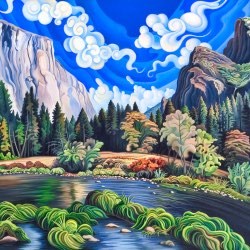
Paintings of YosemiteArtists have been drawn to capture the magnificence of Yosemite since humans first set foot on the land, from the American Indian basketweavers to the plein air artists of today. They paint the grandeur of the massive granite cliffs and thundering waterfalls as well as the constantly shifting incandescence of this graceful land. In this section, we attempt to provide a perspective on the artist’s eye, to see what they see. Photographer’s Note: To photograph some of these artists’ views, it required lengthy and rugged hikes, carrying only a camera and tripod. Imagine doing a similar hike, without a trail, carrying a canvas, easel, and painting supplies, dealing with wind, blowing dust, and insects. |
Last updated: August 23, 2022
